The Top 8 Things to Do in Paracas, Peru


When you think of Paracas, imagine a place where the desert meets the ocean, offering incredible marine life, adrenaline-pumping paddleboarding (watch out for jellyfish), great seafood, and, unfortunately, mediocre beer.
Paracas is a whole lot of sand dunes and desert… and I hate the desert! Deserts suck the energy right out of me. I just don’t like them, and they don’t like me. But plot twist—the desert in Paracas was spectacular! Paracas needs to be on your Peru itinerary!
My favorite part, and the top must-visit spot, is the Paracas National Reserve. Hands down better than the Islas Ballestas that everyone flocks here for!
What is Paracas famous for?
Paracas is a remarkable slice of Peru—and South America—that combines my least favorite terrain with one of my absolute favorite things—an abundance of ocean life. Located about 250 km (150 miles) south of Lima, in the Ica region, Paracas sits on Paracas Peninsula, home to the Paracas National Reserve, a protected area established in 1975 to preserve both a vast desert and a rich marine ecosystem teeming with wildlife.
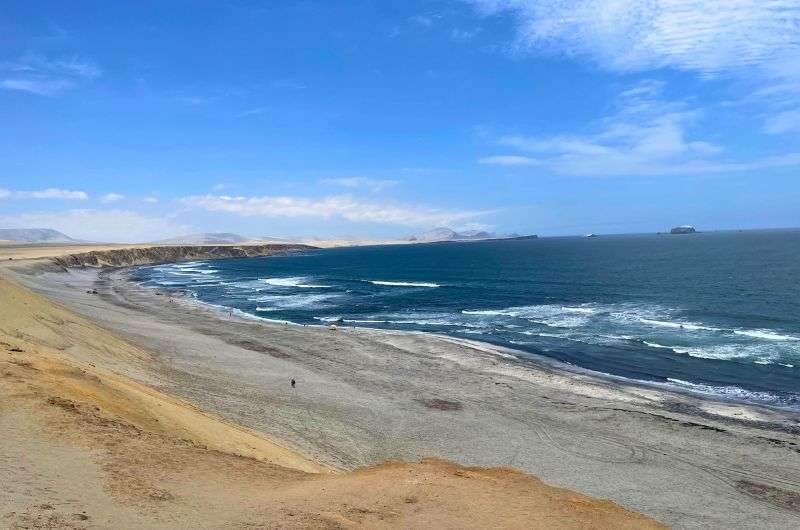
Paracas Nature Reserve
This reserve includes sites from the ancient Paracas culture, with archaeological remains adding a whole new layer of intrigue to this windswept landscape. Although not yet a UNESCO World Heritage Site, the reserve is part of Peru’s Guano Islands, Islets, and Capes National Reserve System, which the country has nominated for UNESCO status.
My list of top things to do in Paracas and around:
- Paracas National Reserve—This place is massive, a fantastic coastal area covering the ocean and desert, a clear highlight in the Paracas region.
- Islas Ballestas—Called the "Poor Man’s Galápagos," the islands are crawling with penguins, sea lions, and incredible bird life you probably don’t see every day.
- Ica vineyards—Visit Peru’s oldest distillery and learn about Peru’s pride and joy: pisco!
- Huacachina oasis with sandboarding— A famous (and touristy) desert oasis with towering sand dunes, where you can try sandboarding and dune buggy rides.
- Nazca Lines and the Paracas Candelabra—These ancient desert etchings are mind-bendingly cool. Closer to town, the Paracas Candelabra is a jaw-dropper you’ll spot from the sea on your Islas Ballestas tour.
- Paddleboarding and kayaking—Ready to paddle through a marine reserve? Or, try a catamaran. I did all three and wouldn’t skip either one.
- Tambo Colorado ruins—Ancient Inca ruins that feel like a surprise out in the middle of the desert.
- La Laguna de Morón—This peaceful oasis is a little slice of desert heaven—no tourist town, no nothing, just a place to chill by the water with zero distractions.
Sometimes, all you need to do is take the first step... I've filtered out the best hotels in Paracas for you
Save it for yourself to come back to later, or share with your friends on social media!
I've already planned your ititnerary for the trip, complete with my travel tips.
Map of things to do in Paracas
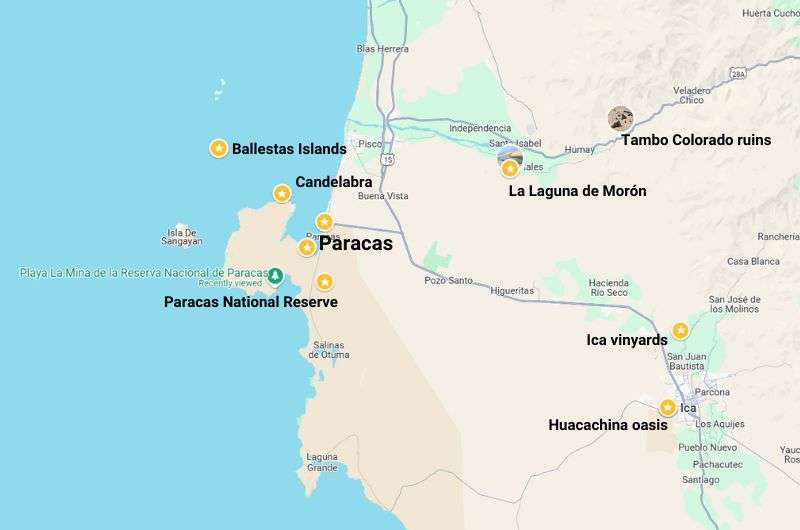
Everything is within 1 hour of Paracas (including the Nazca Lines… if you take a plane tour)
Getting to Paracas from Lima
From Lima, reaching Paracas is a scenic 3-hour drive (about 250 km or 150 miles) along the Pan-American Highway. The road is well-maintained, and the drive offers stunning views of Peru’s dramatic coastline and rolling dunes—a visual treat, especially for those of us used to landlocked landscapes. The sand isn’t the usual yellow color; it is in shades of pinks and reds.
Nearest airport
If driving isn’t an option, the closest airport is in Pisco, about 15 minutes from Paracas. Currently, there aren’t regular commercial flights from Lima to Pisco, but if that changes, it could be a great alternative for reaching Paracas directly.


Get your four-wheel vehicle and let's drive the sand dunes to Paracas!
My top tips for visiting Paracas:
- Paracas National Reserve is far superior to the more popular Ballestas Islands. We visited both, but if you’re in a time crunch and need to skip one, make it the Ballestas Islands.
- Be sure to visit Paracas as a full-on destination in Peru. You’ll easily spend 3 full days if you want to experience all the top things to do in Paracas. 2 days is the absolute minimum.
- Stay at The Legend by Hyatt, which took over the DoubleTree Resort by Hilton Hotel that I loved so much. And when you do, let me know if it’s still a fantastic hotel. I mean it’ll still have those pools and location right on the beach, but you never know what they’ll do to the design and service.
- Remember the Nazca Lines are a 3-hour drive from Paracas, so make an overnight trip of it if you plan on seeing them, or, better yet, take a plane tour out there.
And finally, my list of the best things to do in Paracas:
1. Explore Paracas National Reserve
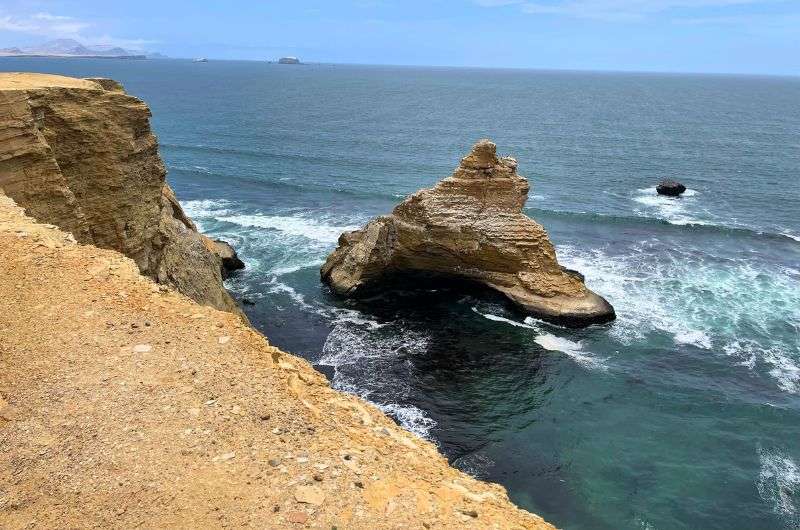
Paracas National Reserve—number 1 thing to do in Paracas
Distance from Paracas: 2 km (1 mi)
Time spent there: 3–4 hours
My favorite place in the Ica region is Paracas National Reserve. It’s full of fauna; there are all kinds of birds, seals, penguins, whales and other critters, like snakes. The desert here is vast and beautiful (photos don’t do it justice!), and, coupled with the blue and turquoise shades of the ocean, is truly a memorable sight. It reminded me of the desert in Namibia, just a little cooler (I mean temperature-wise).
Paracas translates to “sand falling like rain”, and you know what that entails when you get back to your hotel and take your clothes off, only to find a pile of sand under you. You’ll be finding sand in your stuff even after you return home, like itty bitty reminders that you did, in fact, visit the Paracas desert.
Paracas National Reserve map + main stops on the route
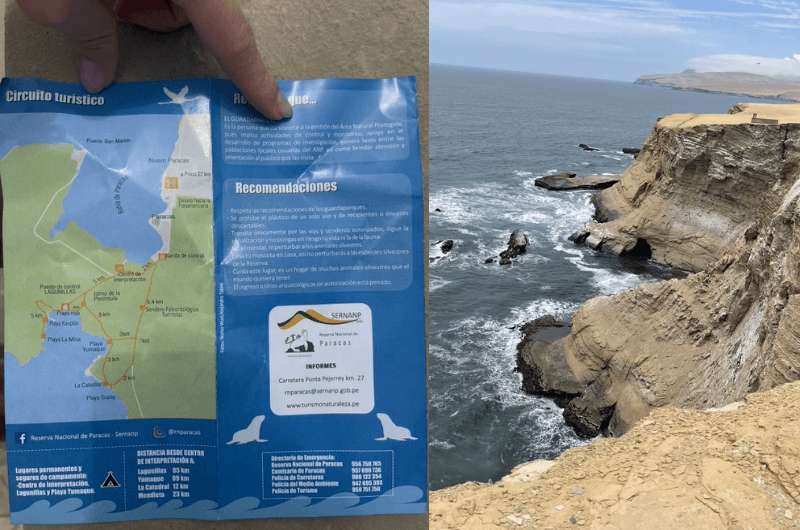
This is the map we got at the entrance to the Paracas National Reserve
The route you’ll follow inside the nature reserve is about 23 km (14 miles) long, and will take you about 4 hours to get through, depending on how long you stop in the individual spots. This is what you’ll see:
- Your first stop will be the interpretation center and museum. There are already massive dunes all around you. You can see huge seashells that are thousands of years old at the interpretation center. (Open daily 8 am–5 pm, tickets cost PEN 11/USD 3.)
The Interpretation Center is connected to the rusty-colored Museum Julio Tello. If you are interested in the history of the Paracas culture, complete with elongated human skulls, stop by for 20 minutes. (Open Tuesday to Sunday 9 am–5 pm, closed Mondays. Tickets cost PEN 7.50/USD 2.)
- Playa Supay is your next stop. The coast is very dramatic here and you can just stand and gaze for 10 minutes and then happily move on. Some people do go down to the beach, but it is officially forbidden, so I didn’t. The bad karma isn’t worth it.
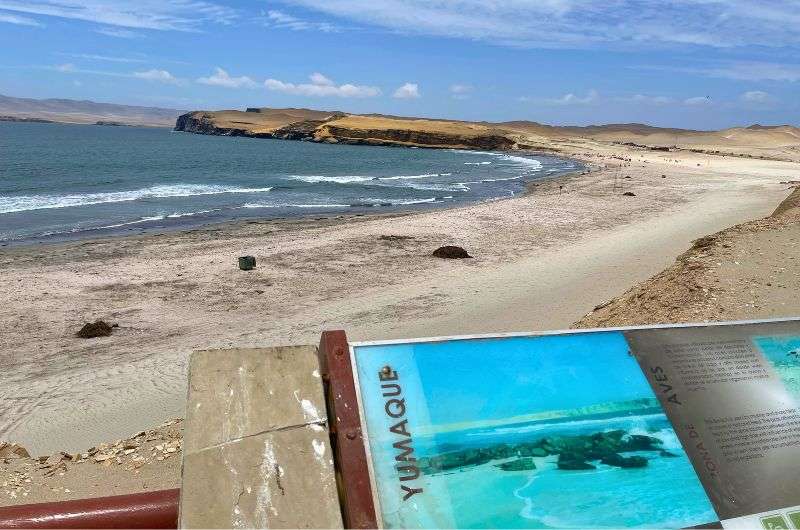
Yumague beach
- La Catedral is a 40-million-year-old rock and the symbol of Paracas. It is now a little island, but it used to be connected to the cliffs of the coast and was taller, hence making it look like a cathedral. After an earthquake in 2007, part of the rock collapsed, and you now only see a triangular rock with penguins on it. 30 minutes.
- Playa Yumanque is a beach, with cliffs! And the views are wonderful, just as they were on the stop before this one, just flatter. But the area feels so vast and empty, you still enjoy it, even though on paper (or a computer screen), it all sounds the same. The wind does pick up in these areas, so come prepared to eat sand. 30 minutes.
- The next stop is more views, this time from the Paracas Isthmus (Mirador Istmo II). 10 minutes should be enough for 75 more photos.
- This one is a highlight and is most popular among tourists: Playa Roja (“Red Beach”), as you might’ve guessed, has sand that is a deep red color. This is caused by the ocean waves picking away at the surrounding cliffs and taking traces of the pink granodiorite, which they are made of, back to the beach. 15 minutes.
The water everywhere along the Peruvian coast is very cold, thanks to the Humboldt Current, but some people (mostly locals) do swim in it. I recommend just using your eyes unless you brought a wetsuit.
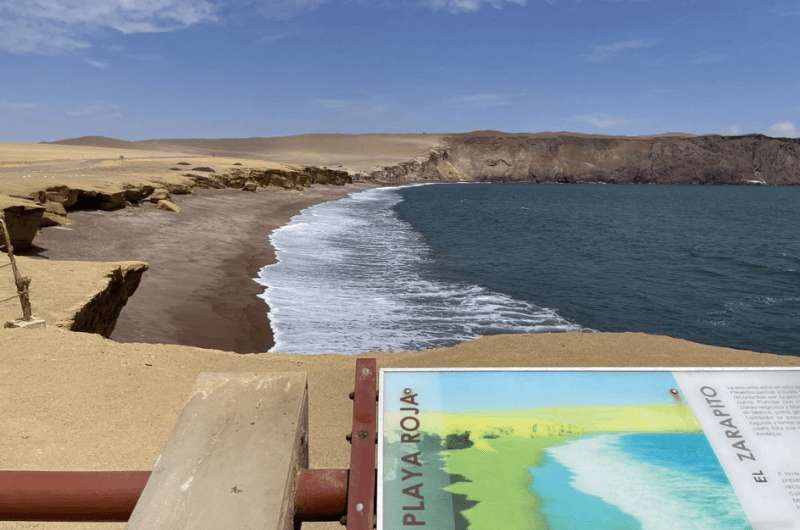
Playa Roja (from this angle it looks like the beach is under a massive cliff and that you’re looking down at it from a height, but in reality it’s like 2 m from where I was standing to the sand!)
- Last but certainly not least, Peru’s most beautiful beach—La Mina. This is where you really wish the water temperature would allow you to feel like you’re in the tropics. It gets crowded with beachgoers, but keep in mind it’s still a wild beach, complete with smelly, rotting corpses of animals here and there.
The area around La Mina is also where you’ll find a few bigger restaurants, usually offering whatever the fisherman brought in that morning, with stunning views out to the ocean (duh, I think you’ve picked up on the theme here). We tried Cevichería La Tia Fela and were very happy. The sea bass fish and chips were really good.
Entering Paracas National Reserve
The main entrance to the Paracas National Reserve is on the road out of Paracas town towards the south. You buy your ticket at the gate, get your map, and can be on your way. The drive through the reserve will take you about 4 hours. The road is easy to navigate, and you don’t need a monster of a vehicle like we had—but it sure was fun!
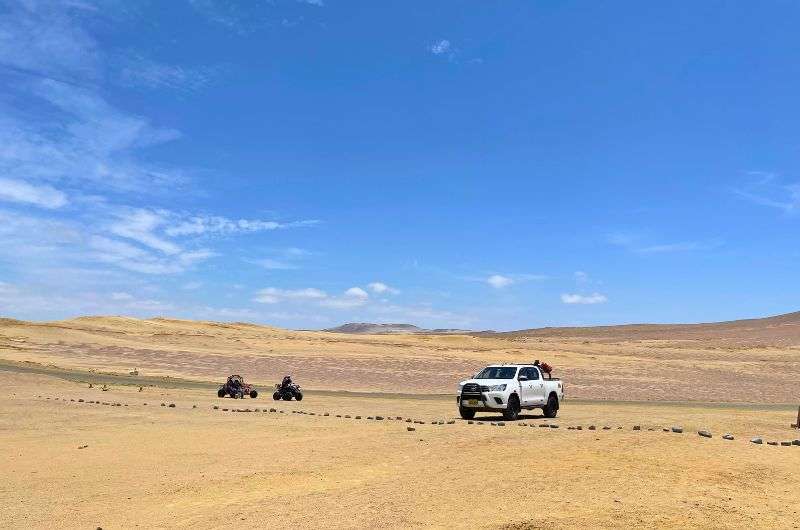
The drive through the whole Paracas National Reserve will take you 4 hours. It’s huge!
There are dune buggy tours that come to Paracas as well, but unless you love sand in your eyes, nose and ears, I really wouldn’t bother.
There are bathroom areas at the main stops on the route, some better, some you wish you hadn’t gone to.
How much does it cost to go to Paracas National Reserve?
Entry to the Paracas National Reserve costs PEN 11 (around USD 3) per person, which includes a map of the reserve. You can pay at the entrance gate and are free to explore the reserve’s scenic route and beaches. Remember, some areas like the interpretation center and Museum Julio Tello have additional fees.
2. Ballestas Islands: a boat trip to see the birds and sea lions
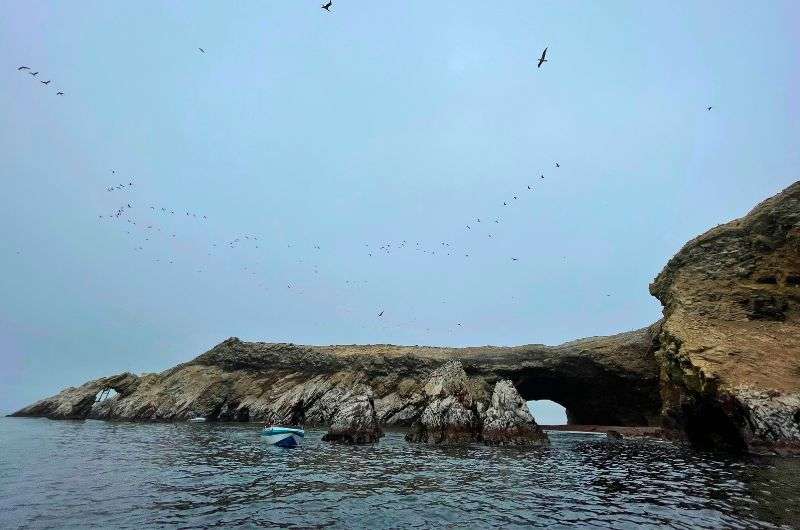
Ballestas Islands
Distance from Paracas: Boat departure is right from town
Time spent there: 2 hours (including the boat tour and watching the wildlife)
For some, the Islas Ballestas are the only reason they visit the Paracas area. I guarantee that many of those people then leave Paracas underwhelmed and wonder why the heck they made the trip.
Luckily for you, you’ll know to focus on the main Paracas National Reserve when you visit Paracas and make the trip out to the poopy rock formations with managed expectations.
See, the trip to the Islas Ballestas is one of the most popular things to do in Paracas, and it takes about 40 minutes on a speed boat. Then you have maybe half an hour “there”, but you aren’t allowed to get off the boat, since the islands are just big rock formations and are protected. So, you take lots of pictures and then spend 40 minutes on the boat trip back. The end.
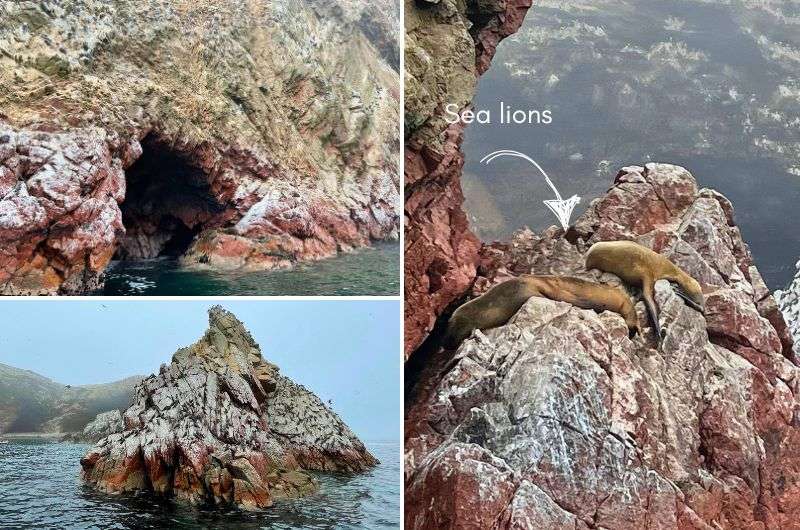
You can spot sea lions, penguins, seals and other animals on Ballestas Islands
Don’t get me wrong, it’s nice—the water is clear, you’ll see tons of seals, sea lions, Humboldt Penguins, and I’ve never seen so many birds in one spot in my life. We even saw dolphins on the trip there. But it isn’t the Galapagos like I read somewhere on the interwebs (I even think “Poor Man’s Galapagos”, the nickname Ballestas Islands got, is a stretch).
The Islas Ballestas are shitty—literally. What do you get when you have a big rock with thousands of birds hanging out on it year-round? Lots of shit. Guano. Poop. Once every few years, the guano layer of a meter or so (3 feet) is harvested by hand and used to make fertilizer. It takes months to finish the job. Where the birds shit during this time I don’t know, but wow—that’s impressive pooping.
A tour will cost you around USD 20, more if you want hotel pick-up included in the price. Try to take a morning trip since the ocean water is calmer and less likely to make you seasick.
I have a full article with practical tips and my experience of the Islas Ballestas boat tour:

3. Ica Vineyards and Peru’s oldest pisco distillery
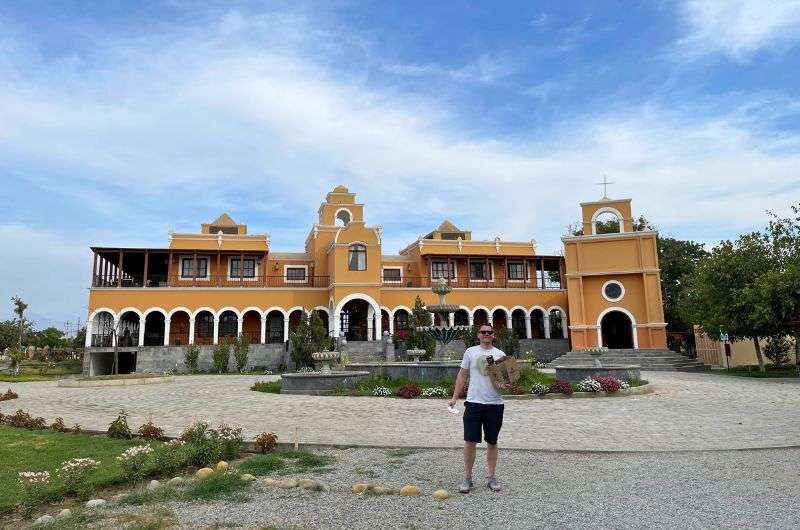
Wine supplies replenished!
Distance from Paracas: 65 km (40 mi)
Time spent there: 3–4 hours (especially if you’re doing a full tasting tour)
Ica is the best day trip from Paracas town. And it makes sense—since Peruvian beer sucks, we thought we’d give their wine a go. But you don’t just get wine, you get pisco! It’s the next level of wine: distilled wine = grape brandy!
I recommend paying a visit to the oldest distillery in South America—established in 1684—, La Caravedo (look for Hacienda Destilería La Caravedo on Google Maps).
When I visited, they gave free tours of the facilities. It took 1.5 hours and was only in Spanish, but you get to try free pisco samples at the end and that makes you want to buy a carton to take home with you. Who knows, if you drink a good amount, you might even begin to speak Spanish.
How to get to Ica Peru

Ica vineyards
An hour away from Paracas, right before you hit Ica, are vineyards. Beware that the road you will be taking looks like you’re driving to someone’s granny’s house, but trust your GPS and persevere. You’ll arrive at a stunning yellow mansion, and you’ll know you’re in the right spot.
Pro tip: The distillery even has accommodation with an incredible looking swimming pool. If you aren’t staying over, at least give the restaurant a visit, the food was amazing!
4. Huacachina desert oasis and sandboarding

Who would have thought that in those sand dunes there was this oasis—Huacachina
Distance from Paracas: 75 km (47 mi)
Time spent there: 2–3 hours (less if you’re not sandboarding)
One of the top fun things to do in Paracas is certainly sandboarding on the mighty dunes in a literal desert oasis—Huacachina.
Fun fact: Huacachina used to be a natural oasis, fed by underground springs. But thanks to nearby farms draining the water supply, it's now on a bit of "oasis life support"—locals pump in water to keep the dreamy desert vibes alive! Read below about visiting La Laguna de Morón, which is, indeed, all natural.
Besides sandboarding, you can get a dune buggy and swish around the sand in that, but that looked like a whole lotta sand in your face and not a lot of anything else to me. Unless you like being thrown out of your seat, jumping up and down over the sand “waves”. You can also ski or get a sand sled.
Swimming in the oasis isn’t safe, so don’t do it. Even the locals say so, and they are some tough cookies, so you better trust them. You can rent a paddle boat instead.
Amenities at Huacachina
A small town has popped up around the oasis with quite a few eating and sleeping options (for a desert oasis!), and of course various sand adventure shops. When you arrive, you will be approached by many touts trying to sell you tours, but keep on walking to whichever shop you researched or booked beforehand.
Dito Sand Xsports, founded by four-time sandboarding world champion Dito Victor Chavez, is one of the best options. They have friendly, professional guides.
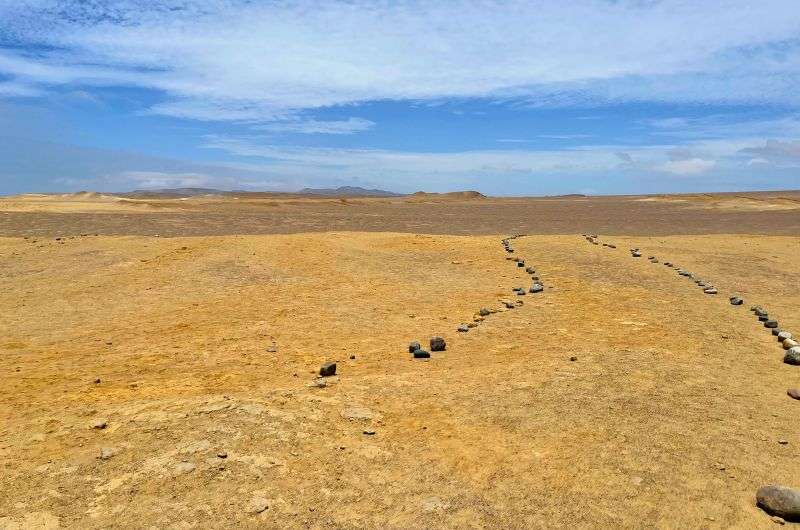
Huacachina
Hotel: The hotels in Huacachina are geared more towards the sandboarding crowd (think surfer dudes and college kids), but Ica is right there and has more options if you’re after a good night’s sleep. If you also plan on trying out some pisco, you might as well stay at La Caravedo (see my previous tip about visiting Ica).
Pro tip: You can combine the two into a sandboarding morning and a grape brandy-filled afternoon. Or, take the evening tour to the dunes and experience a sunset like no other. Sitting on top of the dunes with the oasis town down below is pretty special.
Getting from Paracas to Huacachina
I always rent a car when I travel, and so naturally, I think driving is the way to go. Huacachina is located right next to Ica (see previous item on this list), about an hour’s drive away from Paracas.
5. Nazca Lines: From the ground or on a plane?
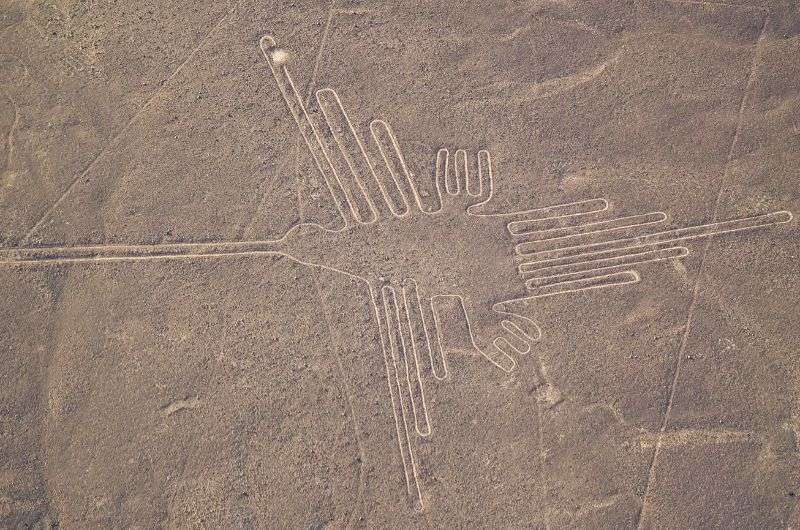
Nazca Lines
Distance from Paracas: Candelabra viewing on Islas Ballestas tour (0 km), Nazca Lines 200 km (124 mi)—I recommend this only as a plane trip from Paracas
Time spent there: 5 minutes (Islas Ballestas boat tours stop for a quick look at Candelabra), 4 (Nazca Lines if you fly there and back)
The Nazca Lines are huge geoglyphs “drawn” on the ground on the plateau to the south of Paracas. They are either long, incredibly straight lines or in shapes such as animals or human figures. Some are simpler designs, and some are more complex. They were made by the Paracas culture in 200 to 400 BCE and by the Nazca people in 200 BCE to 500 CE.
The Nazca Lines are located in a roughly 10x4 km (6x2 mile) rectangle between the towns of Nazca and Pulpa. The is not exactly close to Paracas, it’s at least a 3-hour drive one way, so perhaps plan on booking a hotel in Nazca and stay the night if you plan on driving.
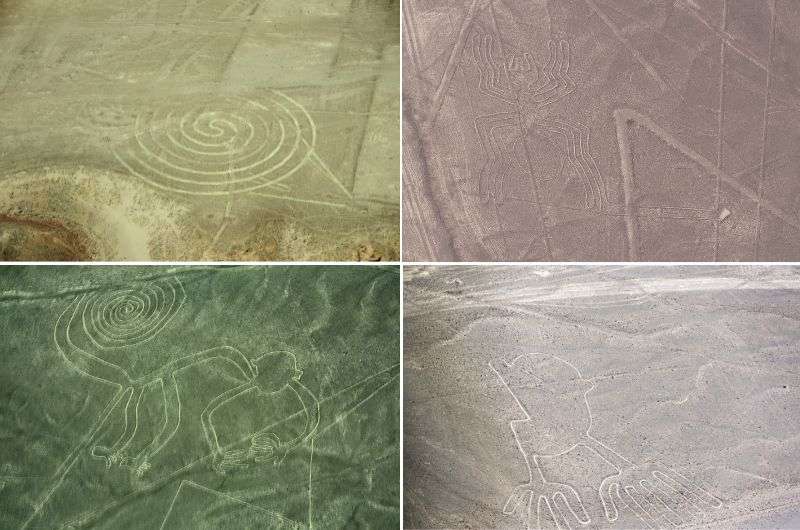
Here you can see a few of the geoglyphs
Not only are the Nazca Lines far away from Paracas, but since the designs are so big, it isn’t easy to take a good look at them from the ground. The best way to see them is from the sky—get a plane trip so you can fully appreciate the shapes, and you don’t have to spend endless hours on the road to get there either.
If you are dead-set on staying on the ground, here are a few places that you can try:
- The Nazca Lines Viewing Tower roughly in the middle between Nazca and Palpa (Mirador de las Lineas de Nazca on Google Maps). It’s literally off the side of the road, as are the Nazca Lines, which might surprise you. Such a special place and there is a highway a few meters away! It costs PEN 5 to go the tower and you can see the tree, hands, and lizard designs.
- The nearby Maria Reiche Museum is next to a natural viewpoint where you can also see some of the designs. Just follow the path. The museum itself is interesting, named after the German archeologist that did some major research into the Nazca Lines.
Nazca Lines plane tour prices
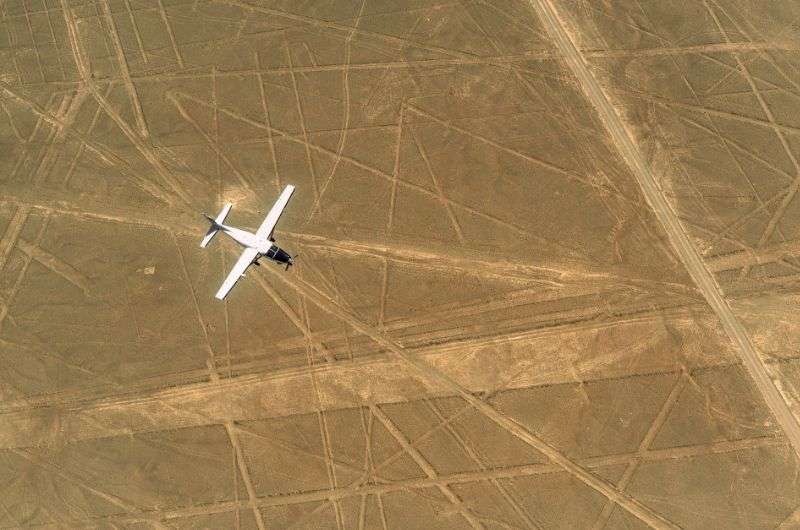
The plane tour gives you the best view of Nazca Lines
For the best views of the full figures and not at skewed angles, you’ll need to board a little single-engine plane at Nazca’s Maria Reiche Airport. Flights depart throughout the day, though the morning trips promise smoother sailing since you don’t get the afternoon winds that are a common occurrence.
- Price: USD 85 per person (beware, airport tax and tourist ticket are often not included in the price and can cost another USD 20).
- Flight duration: Typically 35 minutes, offering views of the most iconic geoglyphs. Longer trips are available for a higher price.
You can also book your trip from Paracas, and you’ll get shuttled off to Pisco airport to board your plane. The extra distance the plane has to travel also means a higher price.
- Price: about USD 300 USD per person.
- Flight duration: Around 1 hour and 40 minutes, covering major geoglyphs and the longer from to and from the airport.
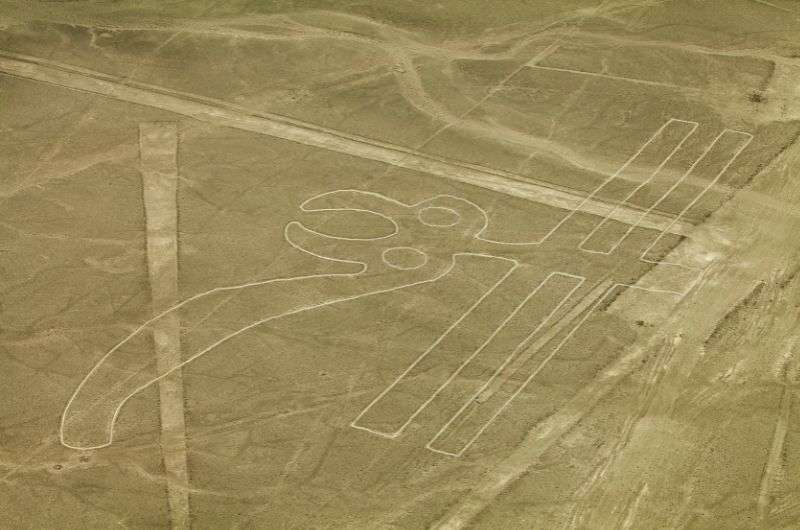
You'll see a lot of different geoglyphs
What are the Nazca Lines?
The lines in this part of Peru were made by removing the top layer of the reddish-brown pebbles on the ground, which then revealed the greyish soil underneath. Since the area is arid, the lines have been preserved naturally and are only occasionally damaged by weather or earthquakes.
As far as measurements are concerned, the lines are commonly about 15 cm (6 in) deep and 33 cm (13 in) wide, and the individual figures can measure anywhere between 400 and 1,100 m (1,300 to 3,200 ft).
Nobody can know for sure what their purpose was, but most scientists agree that they had some sort of religious significance. I have an entire article about the most famous Nazca Line shapes and hypothesis about the origin. It’s fascinating stuff!
6. Paddleboarding and kayaking in Paracas
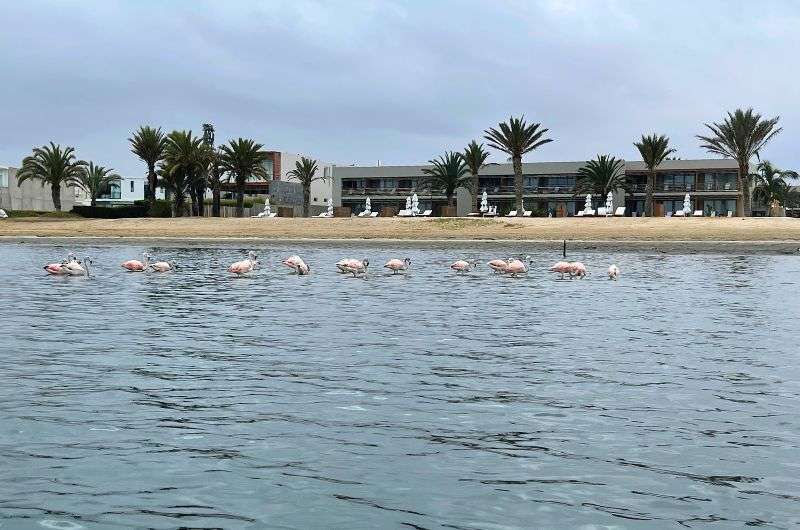
We even spotted flamingos while we were kayaking in Paracas
Distance from Paracas: Right in town
Time spent there: 1–2 hours (depends on your paddling enthusiasm and jellyfish tolerance)
Paracas National Reserve is not only the desert—it’s also a vast marine area. So don’t miss the chance to explore the reserve on the water!
We tried paddle boarding, kayaking, and rented a catamaran—all fantastic options! I’m serious, it wasn’t enough choosing just one of these things, and we ended up going multiple times on each.
We stayed at the incredible DoubleTree by Hilton Hotel in Paracas and all the water activities were included in the price of our stay (as mentioned earlier, it’s now The Legend by Hyatt, so I can’t promise they still have this offer).
Just a word of advice: this is no still lake. Be prepared for an adventure, especially if you are paddle boarding and you have the stability of a, well, me. If you actually manage to get on the thing, you’ll be reminded not to fall into the water by the myriads of huge jellyfish everywhere.
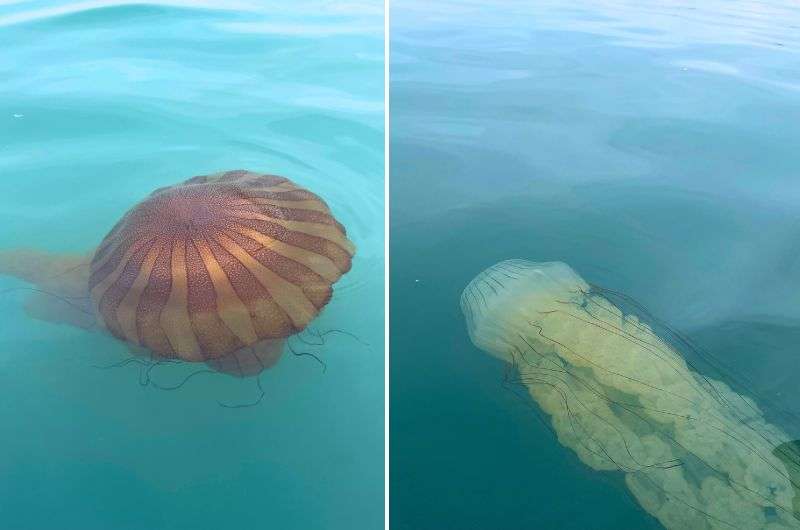
I wouldn’t recommend joining these two giants for a swim
Or you’ll be given a glimpse into nature when a big cloud of black birds decides to dive at full speed into the water close to you, looking for their sardine lunch. They made waves!
After this experience we opted for the comfy kayaks and couldn’t be happier. The catamaran trip is something you should also try if you can.
7. Tambo Colorado ruins—hidden gem alert!
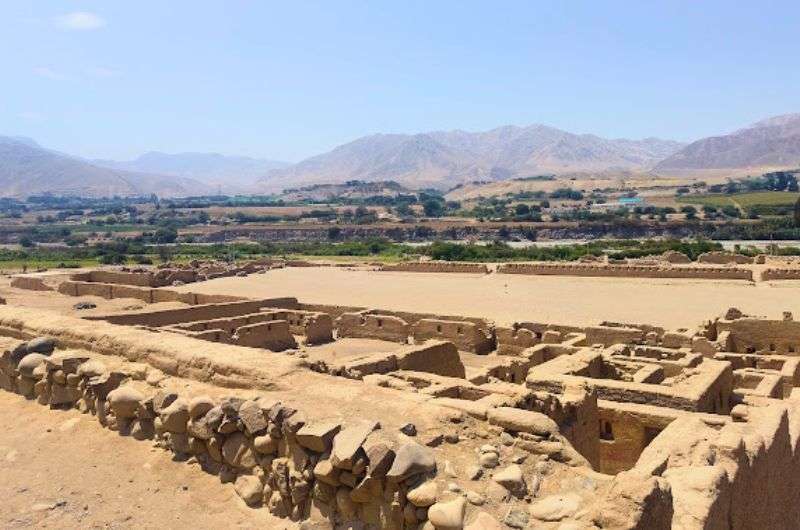
Tambo Colorado ruins
Distance from Paracas: 60 km (37 mi)
Time spent there: 2 hours (perfect for a quick exploration and photos)
The Tambo Colorado ruins are the best-preserved Inca ruins in Peru, yet they are so unknown that few people visit them. They are located about an hour outside of Paracas to the east.
Tambo Colorado is a large and impressive archaeological site. One part that is nice and different to some other more well-known ruins of the world is that you can roam freely and enter any space you decide to explore. There are no roped-off areas.
Opening times are 8 am to 4 pm. You’ll pay PEN 7.50 (USD 2) for a ticket. Allow an hour to see everything.
There isn’t much information at the ruins, so read up beforehand or consider hiring a guide. Just not in a group with 20 other people. Always opt for a smaller group if you can or get a private guide. The hallways are narrow and having someone breathing down your neck could make the ruins lose their appeal quite fast.
You can see places with the original paint still on the adobe walls, or even bits of straw used in the plaster. Cool!
Tip: Interested in ancient civilizations? Read up on the my top 10 ruins in Peru (and how to visit in 2024):

8. La Laguna de Moron—a serene, natural desert oasis
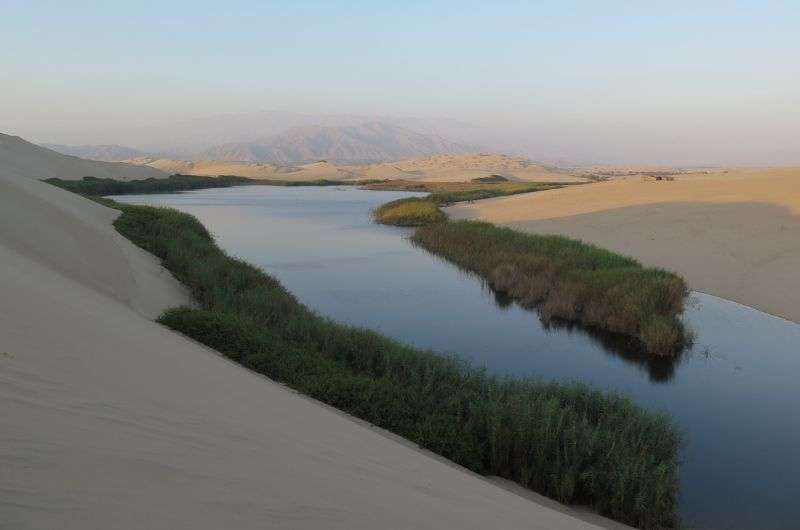
Surrounded by sand dunes is this oasis—La Laguna de Morón
Distance from Paracas: 40 km (25 mi)
Time spent there: 1 hour
Moron is an oasis, like a Huacachina before it got turned into a sandboarding mecca. It’s just a laguna, minding its own business in the middle of the desert, untouched, with no amenities, and no water pumps keeping it wet like at Huacachina.
Great for a little nature trip if you haven’t seen enough desert yet. It’s a 1-hour drive from Paracas or 40 minutes from Pisco. You can drive almost right up to it, park your car, walk 5 minutes, and there you are—Laguna de Moron.
People come here to admire the nature, climb the dunes and even swim in the lagoon. Sometimes you can see local kids here playing and jumping into the water. A few tourist offices take groups here on trips, so you may not be completely alone.
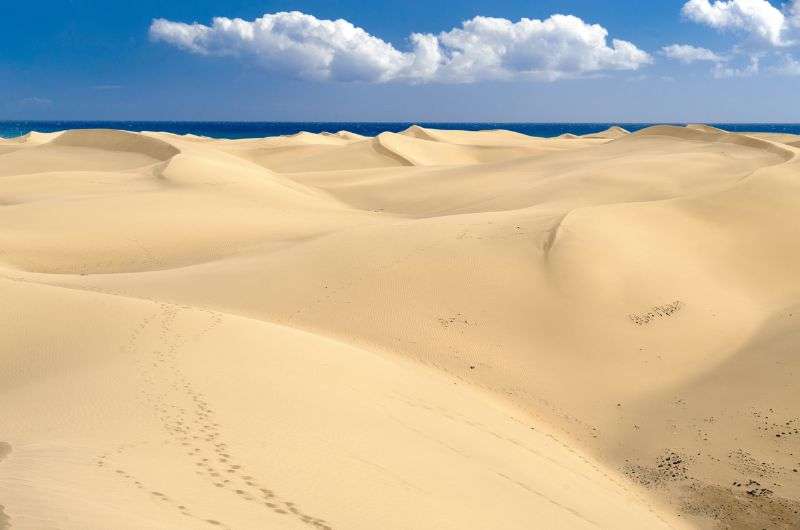
You can have a lot of fun on the sand dunes
One thing to look out for are the motorcycles that race up and down the dunes. If you’re hiking up the dunes, keep your eyes peeled so you don’t get in an accident.
There isn’t much to do at Moron, so if you don’t plan on walking up the dunes or (sun)bathing, you could be done within five minutes.
What is the Paracas culture?
The Paracas culture was a society that lived in the Ica region in 800–100 BCE. Living in the desert, it was a good thing they were masters of water management. Their ingenious irrigation channels funneled water down to the desert from the mountains. To this day, you can still see 3000-year-old channels in some places. Bravo!
Another area where the Paracas excelled were textiles. They would weave, plait and knot complex structures and patterns. Their embroidery was the finest out of all the Andean societies, a real stunner! In Paracas culture, they’d bury their dead as mummy bundles—with the bodies wrapped in layers and layers of this beautiful fabric, bound with a cord into seated position.
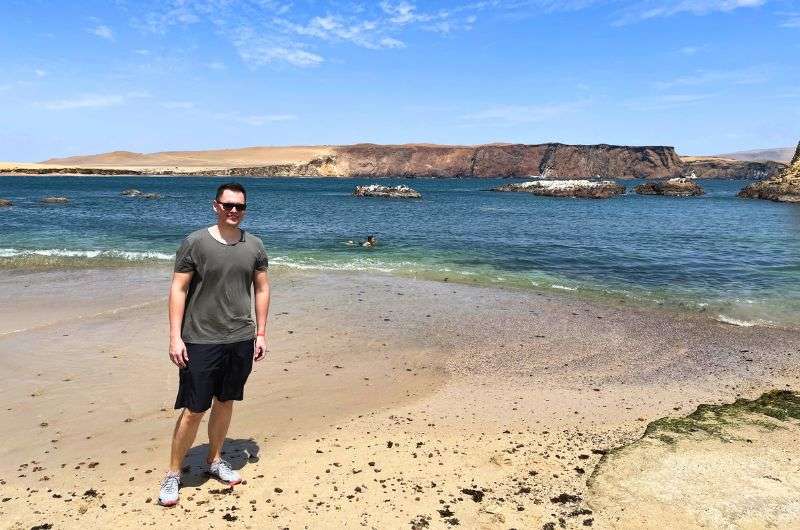
Time for a little history lesson
Cranial deformation, not alien invasion, is why the human skulls of some cultures appear elongated. Various peoples across the planet, from some areas in Africa and America to Oceania, use or have used this practice, usually out of spiritual belief.
The Paracas culture liked cone heads, too. It signified one’s identity, status, as well as beauty, and to protect from evil spirits. You weren’t in with the “it” crowd unless you had a tall, long head. Parents would bind babies’ heads with cloth, forcing it to develop in a different shape than it would naturally. Wait a few months and voila— cone head!
You can see mummies and long skulls at the Museum Julio Tello at the National Reserve, see down below for details.
How long should you spend in Paracas?
To fully enjoy Paracas and its surroundings, plan for 2 to 3 days. In this time, you can explore Paracas National Reserve, take a boat trip to Islas Ballestas, and squeeze in a day trip to Huacachina Oasis and Ica’s pisco vineyards. If you’re really into nature or photography, an extra day will give you more flexibility to soak up the incredible landscapes.
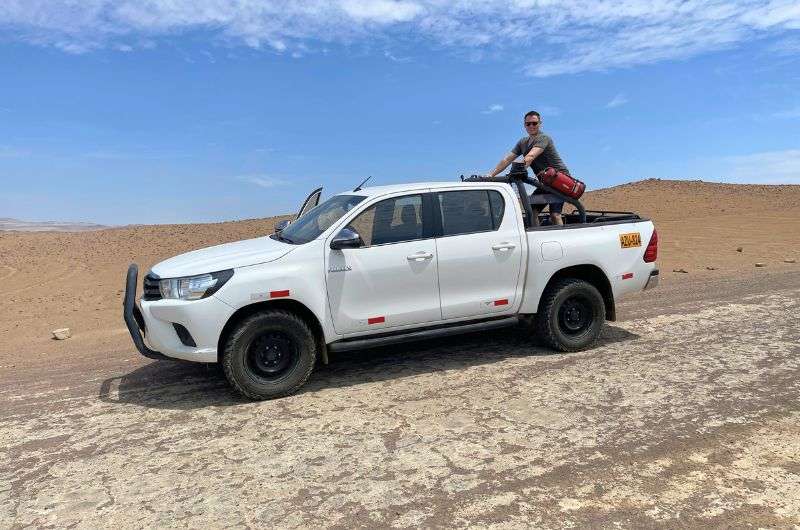
It will take you 2-3 days to drive through the best things to do in Paracas
What is Paracas famous for?
Paracas is famous for its unique combination of desert landscapes, rich marine life, and cultural heritage. The Paracas Peninsula and Paracas National Reserve protect both land and sea, offering habitats for seals, penguins, flamingos, and countless bird species. It’s also known for its ancient history, with archaeological sites from the Paracas culture, and incredible coastal views, including Red Beach and La Catedral rock formation.
Is it better to stay in Paracas or Ica?
For most travelers, staying in Paracas is the better choice. Paracas is closer to the main attractions, including the Paracas National Reserve and Islas Ballestas, and offers beautiful coastal views right from town. Ica is popular for its vineyards and the Huacachina Oasis but is a short drive away, making it ideal as a day trip from Paracas. If you’re into sandboarding and vineyards, consider a night in Ica as part of your stay.
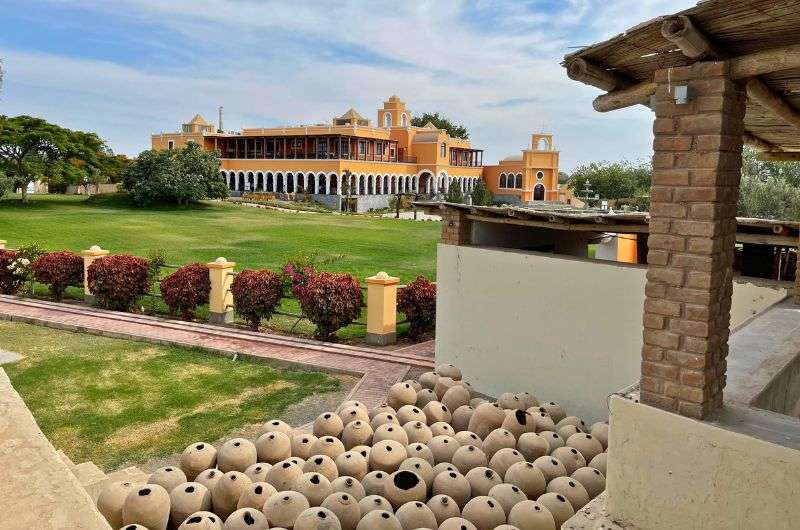
Rest at the vineyards is simply better rest
Can you swim in the ocean in Paracas?
Yes, you can swim in the ocean in Paracas, but be prepared for chilly water! The Humboldt Current keeps the water here quite cold year-round, and it’s usually more for refreshing dips than extended swims. For beach time, head to La Mina Beach in the Paracas National Reserve—it's known as one of Peru’s prettiest beaches.
Sometimes, all you need to do is take the first step... I've filtered out the best hotels in Paracas for you
Save it for yourself to come back to later, or share with your friends on social media!
I've already planned your ititnerary for the trip, complete with my travel tips.
This post contains affiliate links. I earn a small commission if you make bookings through my links, at no additional cost to you. Thank you for your support!




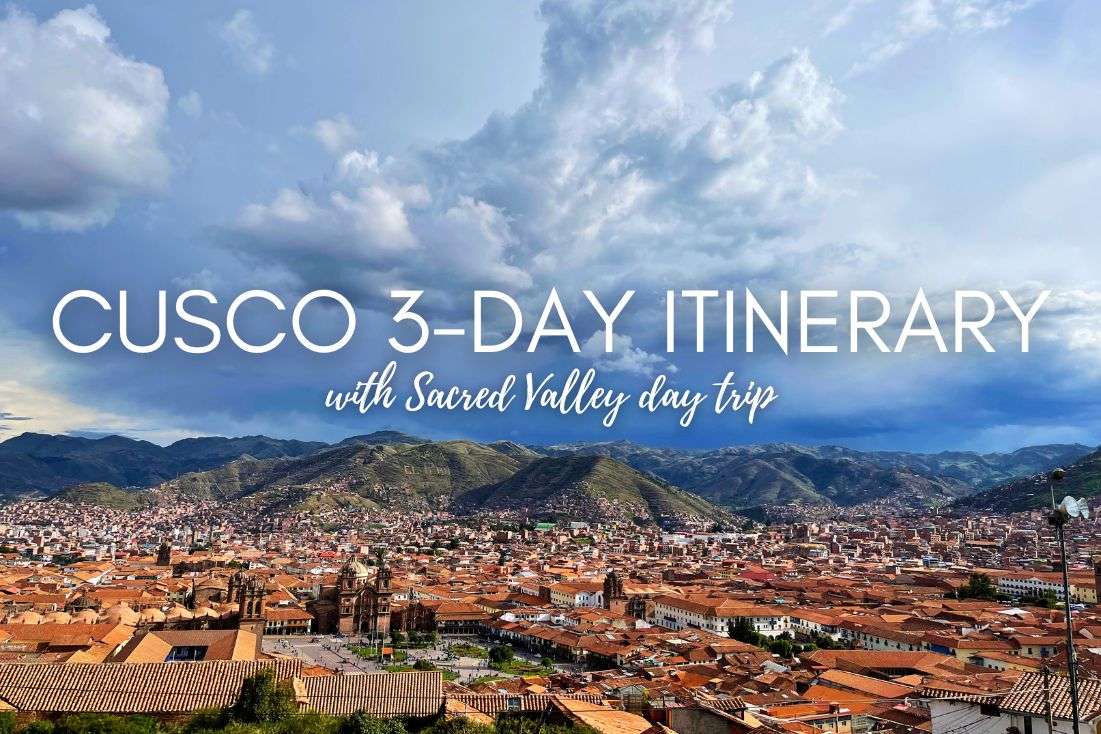





Comments | Thoughts? Give us a shout!